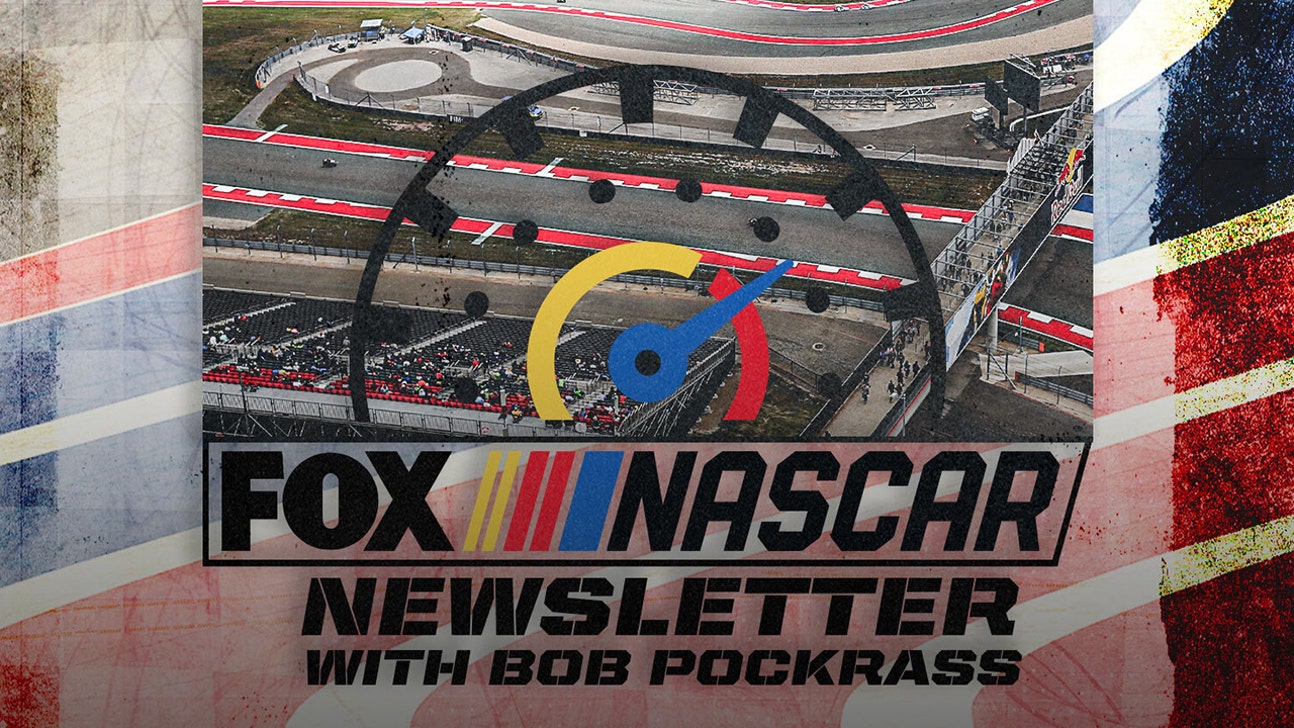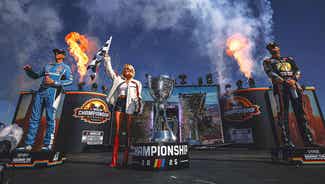
NASCAR's first trip to Circuit of the Americas will be a bumpy ride
By Bob Pockrass
FOX Sports NASCAR Writer
NASCAR makes its first trip to Circuit of the Americas this weekend, and Andy Lally can sum up why fans can see a dicey race on the 3.41-mile track that is just nine years old but has a surface that will challenge stock-car drivers as much as the left-hand and right-hand turns.
"The aggregate is not going to be favorable to any of the NASCAR tire in regard to speed," said Lally, a road-course racer who was the 2011 Cup Rookie of the Year and will race in the Xfinity Series at COTA.
"What that is going to do is make for an amazing race. You’re going to see tires burned off, and you’re also going to see passing come out of the guys that can get their cars working right, get off the corner well and also brake well."
That sounds easy, but it won’t be on a course that has three, four, five or six distinct passing points. Consider this your viewer’s guide for the event and what to watch for that is specific to COTA, which will play host to Camping World Truck Series and Xfinity Series races Saturday and a Cup race Sunday afternoon.
The first passing area could come in Turn 1, where drivers go uphill before making a sharp left.
"It’s a sucker bet into Turn 1," Lally said. "Just as you get into the braking zone, the outside line is parallel with your direction of travel, but then the inside line opens up into this diagonal path, and it will invite some guys to dive bomb into the corner. That’s usually where, in something that’s difficult to brake or doesn’t have ABS [anti-lock brakes], that’s where the mess comes."
With no track limits and a wide runoff area – the track has plenty of wide runoff areas – the drivers could be more than five-wide in that turn as they try to go from 180 mph to as slow as 35 mph.
"It will produce four- or five-wide going into the brake zone, especially if they throw the flag early [on a restart] because you’ll see some pretty brave guys on a pretty low-grip surface trying to make some big gains," Lally continued. "I think it will be a tough place to pass. I think you are going to see guys put quite a bit of emphasis on the restarts."
One of the reasons drivers might take risks is that they might not have another opportunity to pass for the next several turns, a series of esses (named because they shape like an S). Corey LaJoie raced there in an endurance event in December, and he wasn’t driving a car that was in the fastest division.
"If [the faster car] didn’t get around me through that right-hand sweeper, up until the esses, he was stuck behind me because the course is so slow, and those esses tighten up so much," LaJoie said.
"I think if you are somebody who might not be as fast as somebody in front of you, if you can just maintain your position on a restart through [Turns] 1 and 2 and get to the esses, you can maintain that position all the way down into [Turn] 11 and into the hairpin, and it’ll single out, and you can probably maintain for a long time."
Through the esses, it is likely only mistakes will lead to passes.
"You can out-brake someone into there [in Turn 1], but it gets tight quick," Austin Dillon said. "Turn 1 is a struggle to really get off of that corner sometimes, in what I’ve noticed. You can maybe get someone on entry, but it’s probably going to put you in a bad position leaving."
After the esses is a long straightaway that heads into Turn 11, which is another sharp left hander and leads to an even longer straightaway.
"If you’ve got a car that can put the power down and brake, you can get yourself into the corner, get it to turn and get it to drive off," Lally added. "Most everybody is going to be able to do that for two laps. This place is one of those spots where you’re going to see tire degradation right away. [Then] you’re going to see guys nursing tires around. They’re going to figure that out on the practice day."
A 90-degree turn at the end of that straight – drivers will be going from about 160 mph to about 45 mph – could be another passing area entering what is considered the "stadium section" of the track.
"If you had to have a danger zone for the track, that’s your spot," Lally said. "You’re going to see guys get anxious there. You’re going to see guys think they see a hole there, when in fact it’s hardly an invite for a pass, and I think you’re going to see some guys put themselves in spots they shouldn’t be in."
Drivers will weave their way to the final two turns of a lap – two almost 90-degree left-handers that Lally thinks will create incentive for contact. "One of the action spots will be 19 and 20: 19 will be where contact starts and then dump them at 20 going to the line," he added.
Looking for more NASCAR content? Sign up for the FOX Sports NASCAR Newsletter with Bob Pockrass!
With the circuit built for Formula 1, NASCAR has had to make a few adjustments.
It added a 28-inch concrete wall (constructed by Jersey barriers) to form a pit wall that separates the hot side and cold side of pit road. It also took down some of the catchfence that separated the track from the pit area because it blocked the view of the pit road officiating cameras that film from across the track.
It has added speed bumps (known as "turtles") in the first three turn esses to force drivers to make the sweeping curves rather than trying to cut the track.
"The big turtles that we’re putting in – I think we’ll still be able to, if you can get over the turtles without destroying your race car, there’s a lot of track you can use to save it and get back going," driver Tyler Reddick said. "But those turtles are definitely going to tear some stuff up. There’s a lot of room for error if you do make a mistake. I think that will promote drivers to be aggressive and race hard with all the runoff that this track does have."
Because of the tire wear, it isn’t as simple for teams to decide whether to pit prior to the end of the stage and then stay out for track position for the next stage. A few laps of tires could make a great deal of difference.
"That’s the magic question. I’m not sure, but that’s definitely on everyone’s mind," defending Xfinity champion Austin Cindric said. "The road course races, you have that option, as far as pitting before the stages. I would say COTA has a shorter pit road than most tracks, so I think if you’re able to stretch it out far enough, you still have the option to still get stage points if you’re one of the front-runners, so it’s definitely something to look at strategy-wise."
The pit stalls are 29.5 feet in length – the longest NASCAR could get them for a pit road accustomed to accommodating fewer than 30 cars for most of its events, rather than the 40 it will do for NASCAR weekend.
Drivers vary as far as what concerns them. Lally said drivers need to worry about flat-spotting tires in Turn 1. Reddick worries that he needs to be fast through the esses.
"You can kind of pick and choose between where you can make your car stronger," he said. "But it’s tough because you really want to be fast if you have the track position through the esses. That’s a very important part of the lap, and if you nail that right, it’s going to be a great lap. If you miss it, you’re going to have a terrible lap."
Some drivers aren’t going to sweat it. They are going to approach it like they do most road courses.
"I think, in general, the track has a little bit of that just because it’s so unique with high speed and low speed," Martin Truex Jr said. "It’s like Sonoma and Watkins Glen all pushed together. It’s a little different in that aspect. I think as far as road courses go, it’s a road course. I don’t think there’s anything that guys are going to be completely freaked out about or lost about."
For more up-to-date news on all things NASCAR, click here to register for alerts on the FOX Sports app!
Thinking Out Loud
One of the common theories of the Next Gen car is that if someone wants to become a Cup owner, 2022 is the time to do it. The idea is that all teams will be on an equal playing field because no one has a head start on this car.
I agree with the contrarian view: There is no benefit to getting into Cup in 2022, versus coming into it in 2023 or '24. The development of the car is going to be at a rapid pace, so why not let other teams develop the car for a couple of years, hire people who were part of that development and not go through the growing pains?
Teams still don’t know what the cost of the initial rollout to be. Some estimates are $2 million to have a car (including engine) for the season. At seven cars (the max per team) that would be about $14 million. Other estimates are around $4 to $5 million, potentially more than doubling the lower estimate. The costs to replace a crashed car are potentially much higher because most of the parts and pieces are purchased from vendors.
Why not wait? It isn’t going to hurt anything. The cost of a charter depends on the number of people wanting one (the ol’ supply-and-demand), and there is no indication that there will be any more demand in two years than there is now.
Social Spotlight
They Said It
"It’s necessary for each of you to do your job to be probing on this, but for today, we’re going to keep the focus on Fastenal and our partnership, and I will attempt to deflect politely any questions around any of those rumors at this time." – Roush Fenway Racing President Steve Newmark on whether Keselowski is joining the team in 2022 as a driver and co-owner
Bob Pockrass has spent decades covering motorsports, including the past 30 Daytona 500s. He joined FOX Sports in 2019 following stints at ESPN, Sporting News, NASCAR Scene magazine and The (Daytona Beach) News-Journal. Follow him on Twitter and Instagram @bobpockrass. Looking for more NASCAR content? Sign up for the FOX Sports NASCAR Newsletter with Bob Pockrass!










